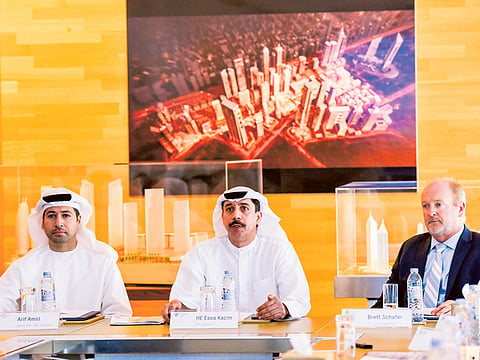DIFC aims to be 3 times bigger by 2024
DIFC wants to shift from being financial centre to full-fledged hub; wants financial services to contribute 18% of GDP

Dubai: Dubai International Financial Centre (DIFC) aims to be three times bigger in terms of number of firms, employees, assets under management and expects the growth to be driven by expanding this as a hub for linking Asia Pacific with the regional markets, its senior official said on Wednesday.
The DIFC, which started operations in 2004, and attracted 19 firms during inception, now boasts more than a 1,000 firms with 18,000 employees, and going forward the DIFC wants to shift from being a financial centre to a full fledged hub.
“In the next 10 years, our plan is to triple the size of DIFC in terms of number of companies operational in the DIFC, number of people, occupied space, assets under management,” Eisa Kazim, Governor of (DIFC) said at a press conference.
“We are aligning our strategy with Dubai’s overall strategy of achieving growth in terms of attracting leading businesses, and becoming a headquarters of companies,” Kazim said.
DIFC’s focus would be linking the economies of the world with the markets of the region.
“We will be encouraging the current clients of the DIFC in terms of doing more activity. Majority of the companies that are currently involved engage in front office activity. There are areas that pertains to capital markets activities like syndicates, debt market, equities, investment banking activities,” he added.
Signs
We saw some signs in the last quarter of last year, when big IPOs got listed on the Dubai Financial Market, that heavily involved investment banking activities based in DIFC. We would encourage them to do more,” Kazim said.
“The other area of growth for us, which we feel the potential is huge and it is not fully tapped, is [gaining] relevance in global sectors, is family offices, asset and wealth management in addition of attracting businesses in the region.”
Assets that are available with the pension funds, sovereign wealth fund, is about $7-8 trillion. The last area of growth, which the DIFC expects to contribute 50 per cent by building south-south corridor, is linking Asia Pacific with the markets of the region.
The combination of strategic geographical location and developed air-sea links to access international trade routes has turned Dubai into an entry point and a major export and re-export hub. Trade among emerging economies is increasing rapidly with Africa, Latin America, South Asia and Middle East (South-South Corridor) witnessing dynamic growth.
The geoeconomic development has led to the emergence of Dubai as a gateway to Middle East, South Asia and Africa, particularly for Asian and Middle Eastern companies.
“We will be attracting regional financial institutions, which is very much limited. The focus would also be selective financial institutions from Africa, sub-Saharan Africa, and also on the Asia Pacific region, by allowing them to position their regional office in Dubai and in DIFC,” he added.
New dimension
The new dimension to the growth areas would be Islamic economic activities. Dubai is trying to position itself as a global hub for Islamic finance.
“We have been very successful in becoming a hub for sukuk listing. Our sister platform Nasdaq Dubai has been very active and the figures speak for themselves,” he added.
The total nominal value of all conventional bonds listed on Dubai’s exchanges is at $11.32 billion, the largest total of any exchange in the region.
This strategy of the DIFC would also add to the contribution to financial services as part of the GDP to 18 per cent in 2024 from 6 per cent now.
Sign up for the Daily Briefing
Get the latest news and updates straight to your inbox



